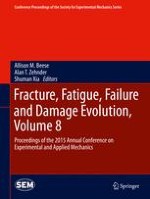Fracture, Fatigue, Failure and Damage Evolution, Volume 8 represents the eighth of nine volumes of technical papers presented at the Society for Experimental Mechanics (SEM) 15th International Congress & Exposition on Experimental and Applied Mechanics, held at Costa Mesa, California, June 8-11, 2015. The full set of proceedings also includes volumes on: Dynamic Behavior of Materials, Challenges in Mechanics of Time Dependent Materials, Advancement of Optical Methods in Experimental Mechanics, Experimental and Applied Mechanics, 16th International Symposium on MEMS and Nanotechnology, International Symposium on the Mechanics of Composite and Multi-functional Materials, 5th International Symposium on the Mechanics of Biological Systems and Materials, International Symposium on the Mechanics of Composite and Multi-functional Materials; and Residual Stress, Thermomechanics & Infrared Imaging, Hybrid Techniques and Inverse Problems.
